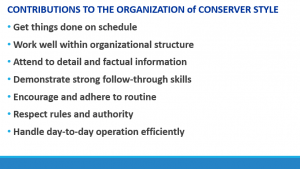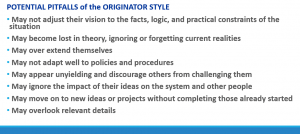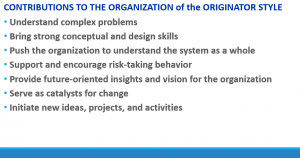Change is constant, and how we each view and deal with it–understanding, flexing to and even using different Change Styles–is an important detail in our team, leadership and organization development efforts.
Change Styles Example
Claudette and Jim each manage one of two separate but interdependent divisions. New senior leadership is driving a number of structural, technological and procedural changes, and while Jim and Claudette need to cooperate and collaborate, they each find it quite challenging to do so because of the way each regards the other around this change.
Jim: The Originator/Airhead
Jim has long wanted to make the proposed changes and many more. He is excited by these new mandates and is leaning into them with enthusiasm. He is actually frustrated by Claudette’s reluctance and unnecessary caution. Her many questions and insistence on delving into details and minutiae make her feel rather like an anchor. Jim is chomping at the bit to see where and how far both divisions could reach if cut loose to run.
Claudette: The Conserver/Anchor
Claudette has been a leader and project manager for a long time, and she has seen “flavor of the month” change initiatives come and go. She has shepherded many projects and this division through many lean and uncertain times. Her prudence and caution have averted chaos and saved the company money many times. She feels like the new mandated changes from the Senior Team are the latest test of her steady, skeptical hand. Jim is a frustration to her, for he seems to leap without care or forethought into change for change’s sake. While he’s been lucky a time or two in the past, his tendency to disregard caution and facts make him an unreliable partner. Claudette sees Jim as a bit of an airhead, and she struggles to take him seriously.
Claudette and Jim need to collaborate, but the negative frame within which they each hold the other makes this very challenging. Considering the Change Style that identifies each of them is a much more accurate and helpful way to understand this key difference they have.

Change Style Indicator (CSI)
Since the early 1990s, the Change Style Indicator—or CSI—has been the leading voice in change and change styles in the field of Learning & Development. The CSI is a personal style assessment widely used to support leadership and team development. The CSI measures an individual’s preferred style in approaching and addressing change. The CSI places each participant on a continuum line stretching from Conserver on one end to Originator on the other—three primary styles with a number of more detailed distinctions emerge.
Training with the CSI helps leaders and teams consider all perspectives when resolving issues to increase collaboration; it enables a group’s creativity and innovation, and it improves teamwork through the increased understanding of both the advantages and strengths that each style brings to an organization.
Putting Change Styles to Work
Jim is frustrated by Claudette’s skepticism and caution. These are the downsides or pitfalls of Claudette’s approach to change, but an understanding of the Conserver Change Style paints a more full and useful picture and gives ways to approach and even use Claudette’s Change Style to the organization’s benefit–and even to make up for some of Jim’s own pitfalls.
Jim admits that whatever change does come about is benefited by Claudette’s practical, historically-informed ability to follow through and implement.
Claudette can fall into the trap of seeing only Jim’s downsides–the way he feeds her fears and turns a blind eye to chaos and inefficiency; however, Jim’s approach to change offers many benefits to the division as well as some cushioning to the challenges that she herself tends to bring to her role and responsibilities.
Claudette, while comfortable and confident in the management of detail and in cautious movement forward, does falter when facing the unknowns that the future holds and does approach ambiguity with clear anxiety. Jim does seem to have a much more positive and energized view of the future and its promise than she.
The benefit of the CSI–as a tool and as an approach to change–is that it not only frames change and Change Styles differently, but it shows us each what we could actually DO to avoid the pitfalls of our natural approach to change, leading to more style flexibility and productivity.

OKA can help get you certified in the CSI or deliver a leading change workshop onsite for your team.
Click here to learn more about OKA’s unique approach to CSI Certification.
Click here for more information on how OKA can bring a CSI training event to your group or team.







Leave a Comment